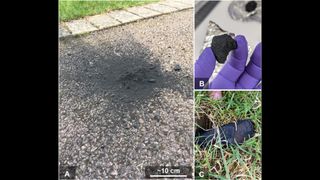Meteorite that landed in English village last year is most pristine ever seen
The meteorite is almost as unchanged by Earth's environment as samples returned by space probes.

A meteorite that lit up the sky above an English village last year is almost as pristine as samples collected by space probes and contains the "right" kind of hydrogen to explain water on Earth, scientists say.
A huge furor erupted when a fireball rattled through the evening sky above southwestern England on Feb. 28, 2021. Dozens of meteor cameras and doorbell webcams caught a glimpse of the bright streak, and a 1-pound (0.5 kilograms) fragment of the space rock was promptly found in the driveway of a home in the village of Winchcombe, after which the meteorite was later named.
The speedy discovery meant the meteorite was barely exposed to Earth's elements, allowing it to maintain its pristine chemical composition. In fact, the Winchcombe meteorite's composition is so pristine it can nearly match samples collected by space probes such as NASA's OSIRIS-REx from asteroids in space, researchers said in a new study.
Related: How scientists found rare fireball meteorite pieces on a driveway — and what they could teach us
The analysis of this precious rock has yielded fascinating results that seem to support the theory that Earth's water came primarily from asteroids. The Winchcombe space rock contains hydrogen atoms with an isotopic composition that is quite similar to that in Earth's water. Isotopes are varieties of the same chemical elements that differ by the number of neutrons in their atomic nuclei. Other possible sources of Earth's water, such as comets, have been found to contain water with different isotopic profiles.
The analysis also found that the meteorite must have broken off from its parent asteroid fairly recently in the cosmic scheme of things — only 200,000 to 300,000 years ago. Most meteorites, scientists said in the paper, spend millions of years in interplanetary space before their paths cross with that of Earth, and during that time they get ravaged by cosmic rays and solar wind.
By analyzing data from the cameras that captured the Winchcombe meteorite's cruise through Earth's atmosphere, astronomers were able to reconstruct the rock's orbit and determine that its parent asteroid resides in the main asteroid belt between the orbits of Mars and Jupiter rather than among the near-Earth asteroid population.
Get the Space.com Newsletter
Breaking space news, the latest updates on rocket launches, skywatching events and more!
The Winchcombe meteorite is a carbonaceous chondrite, a rare class of meteorites that is believed to come from very primitive asteroids that migrated to the main asteroid belt from the outer edges of the solar system. Scientists think that the chemical composition of these asteroids has barely changed since the solar system's birth. And that means that, thanks to its unspoiled nature, the Winchcombe meteorite provides a unique view into these ancient "time capsules".
In addition to the right types of hydrogen, the meteorite also contains organic material of the kind that could have given rise to life on Earth some 3.5 billion years ago, the scientists said in a statement.
Overall, the Winchcombe meteorite was a very lucky strike.
"Direct links between carbonaceous chondrites and their parent bodies in the solar system are rare," the scientists said in the paper. "The Winchcombe meteorite is the most accurately recorded carbonaceous chondrite fall."
Only four carbonaceous chondrites' journeys through Earth's atmosphere have been observed to date so well that their origins could be determined. Most of the others discovered "are fortuitous finds that lack information about their source region in the solar system," the researchers said in the paper.
The study describing the first analysis of this precious rock was published on Nov. 16 in the journal Science Advances.
Follow Tereza Pultarova on Twitter @TerezaPultarova. Follow us on Twitter @Spacedotcom and on Facebook.
Join our Space Forums to keep talking space on the latest missions, night sky and more! And if you have a news tip, correction or comment, let us know at: community@space.com.

Tereza is a London-based science and technology journalist, aspiring fiction writer and amateur gymnast. Originally from Prague, the Czech Republic, she spent the first seven years of her career working as a reporter, script-writer and presenter for various TV programmes of the Czech Public Service Television. She later took a career break to pursue further education and added a Master's in Science from the International Space University, France, to her Bachelor's in Journalism and Master's in Cultural Anthropology from Prague's Charles University. She worked as a reporter at the Engineering and Technology magazine, freelanced for a range of publications including Live Science, Space.com, Professional Engineering, Via Satellite and Space News and served as a maternity cover science editor at the European Space Agency.
